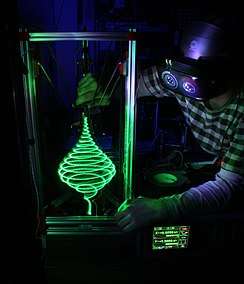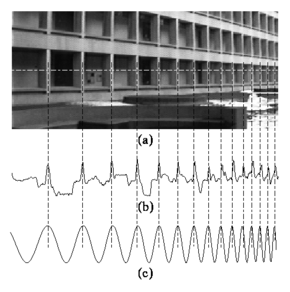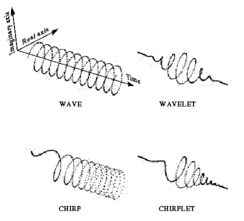Chirplet transform
In signal processing, the chirplet transform is an inner product of an input signal with a family of analysis primitives called chirplets.[2][3]

Similar to the wavelet transform, chirplets are usually generated from (or can be expressed as being from) a single mother chirplet (analogous to the so-called mother wavelet of wavelet theory).
Definitions
The term chirplet transform was coined by Steve Mann, as the title of the first published paper on chirplets. The term chirplet itself (apart from chirplet transform) was also used by Steve Mann, Domingo Mihovilovic, and Ronald Bracewell to describe a windowed portion of a chirp function. In Mann's words:
A wavelet is a piece of a wave, and a chirplet, similarly, is a piece of a chirp. More precisely, a chirplet is a windowed portion of a chirp function, where the window provides some time localization property. In terms of time–frequency space, chirplets exist as rotated, sheared, or other structures that move from the traditional parallelism with the time and frequency axes that are typical for waves (Fourier and short-time Fourier transforms) or wavelets.
The chirplet transform thus represents a rotated, sheared, or otherwise transformed tiling of the time–frequency plane. Although chirp signals have been known for many years in radar, pulse compression, and the like, the first published reference to the chirplet transform described specific signal representations based on families of functions related to one another by time–varying frequency modulation or frequency varying time modulation, in addition to time and frequency shifting, and scale changes. In that paper, the Gaussian chirplet transform was presented as one such example, together with a successful application to ice fragment detection in radar (improving target detection results over previous approaches). The term chirplet (but not the term chirplet transform) was also proposed for a similar transform, apparently independently, by Mihovilovic and Bracewell later that same year.[3]
Applications

The chirplet transform is a useful signal analysis and representation framework that has been used to excise chirp-like interference in spread spectrum communications,[4] in EEG processing,[5] and Chirplet Time Domain Reflectometry.[6]
Extensions
The warblet transform[7][8][9][10][11][12] is a particular example of the chirplet transform introduced by Mann and Haykin in 1992 and now widely used. It provides a signal representation based on cyclically varying frequency modulated signals (warbling signals).
See also
- Other time–frequency transforms
References
- From page 2749 of "The Chirplet Transform: Physical Considerations", S. Mann and S. Haykin, IEEE Transactions on Signal Processing, Volume 43, Number 11, November 1995, pp. 2745–2761.
- S. Mann and S. Haykin, "The Chirplet transform: A generalization of Gabor's logon transform", Proc. Vision Interface 1991, 205–212 (3–7 June 1991).
- D. Mihovilovic and R. N. Bracewell, "Adaptive chirplet representation of signals in the time–frequency plane," Electronics Letters 27 (13), 1159–1161 (20 June 1991).
- Bultan, Akansu; Akansu, A.N. (May 1998), "A novel time-frequency exciser in spread spectrum communications for chirp-like interference", Proceedings of the IEEE International Conference on Acoustics, Speech and Signal Processing (ICASSP), 6, pp. 3265–3268, doi:10.1109/ICASSP.1998.679561, ISBN 0-7803-4428-6
- Cui, J.; Wong, W.; Mann, S. (17 February 2005), "Time–frequency analysis of visual evoked potentials using chirplet transform" (PDF), Electronics Letters, 41 (4), pp. 217–218, doi:10.1049/el:20056712, retrieved 2010-07-29
- "Example Programs - National Instruments". Archived from the original on 2012-02-14. Retrieved 2007-12-31.
- Mann, Steve, and Simon Haykin. "'Chirplets' and'warblets': novel time-frequency methods." Electronics letters 28, no. 2 (1992): 114-116.
- Mann, S., & Haykin, S. (1992, March). Time-frequency perspectives: the chirplet transform. In Acoustics, Speech, and Signal Processing, 1992. ICASSP-92., 1992 IEEE International Conference on (Vol. 3, pp. 417-420). IEEE.
- Angrisani, L., D'Arco, M., Moriello, R. S. L., & Vadursi, M. (2005). On the use of the warblet transform for instantaneous frequency estimation. Instrumentation and Measurement, IEEE Transactions on, 54(4), 1374-1380.
- Angrisani, L., Arco, M. D., Moriello, R. S. L., & Vadursi, M. (2004, August). Warblet transform based method for instantaneous frequency measurement on multicomponent signals. In Frequency Control Symposium and Exposition, 2004. Proceedings of the 2004 IEEE International (pp. 500-508). IEEE.
- Kazemi, S., Ghorbani, A., Amindavar, H., & Morgan, D. R. (2016). Vital-Sign Extraction Using Bootstrap-Based Generalized Warblet Transform in Heart and Respiration Monitoring Radar System.
- Zelinsky, N. R., & Kleimenova, N. G. Chirplet transform as the useful tool for study the time-frequency structure of geomagnetic pulsations.
- Mann, S.; Haykin, S. (21–26 July 1991), "The adaptive chirplet: An adaptive wavelet like transform", SPIE, 36th Annual International Symposium on Optical and Optoelectronic Applied Science and Engineering, Adaptive Signal Processing, 1565: 402–413, doi:10.1117/12.49794 LEM, Logon Expectation Maximization
- Mann, S.; Haykin, S. (1992). "Adaptive chirplet transform". Optical Engineering. 31 (6): 1243–1256. Bibcode:1992OptEn..31.1243M. doi:10.1117/12.57676. introduces Logon Expectation Maximization (LEM) and Radial Basis Functions (RBF) in Time–Frequency space.
- Osaka Kyoiku, Gabor, wavelet and chirplet transforms...(PDF)
- J. "Richard" Cui, etal, Time–frequency analysis of visual evoked potentials using chirplet transform, IEE Electronics Letters, vol. 41, no. 4, pp. 217–218, 2005.
Florian Bossmann, Jianwei Ma, Asymmetric chirplet transform--Part 2: phase, frequency, and chirp rate, Geophysics, 2016, 81 (6), V425-V439.
Florian Bossmann, Jianwei Ma, Asymmetric chirplet transform for sparse representation of seismic data, Geophysics, 2015, 80 (6), WD89-WD100.
